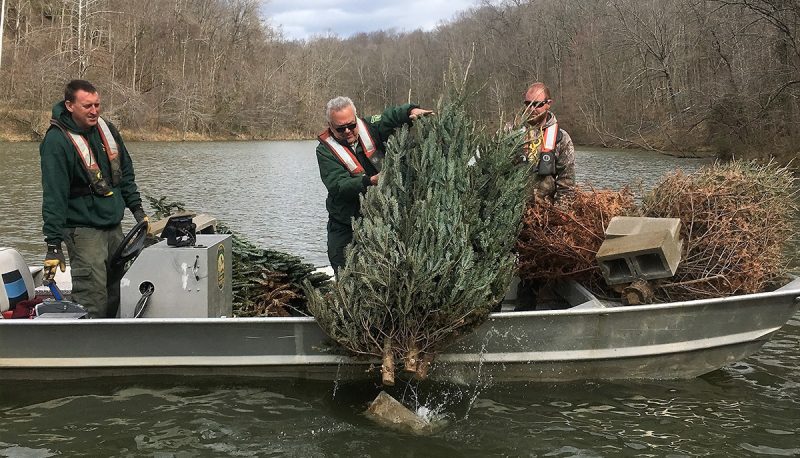Murilo Morata, Agriculture and Natural Resources Extension Agent, UF/IFAS Extension Escambia County
As the festive season approaches, millions of households across the country prepare to celebrate with live Christmas trees, bringing the warmth and cheer of the holidays into their homes. But once the season is over, many wonder what to do with their tree. Instead of simply discarding it, why not give your tree a second life by repurposing it for environmental and community benefits?
One creative and eco-friendly way to recycle your Christmas tree is by using it to enhance aquatic habitats. Submerging Christmas trees in ponds or lakes can create critical habitat for fish, support aquatic ecosystems, and improve biodiversity.
–
Enhancing Aquatic Habitat with Christmas Trees
When submerged in water, Christmas trees contribute significantly to the complexity of aquatic environments. The intricate branching of coniferous trees provides shelter for prey fish, like sunfish and perch, creating a refuge from predators. These branches also produce shadows that camouflage smaller fish and encourage them to congregate. Additionally, the woody material serves as a substrate for aquatic macroinvertebrates, which are a key food source for insect-loving species like bluegill. Over time, the presence of submerged trees enhances fish species diversity, richness, and abundance. Predatory fish like bass are also drawn to these habitats due to the availability of prey.
–
Steps for Repurposing Christmas Trees in Ponds
- Preparation: Remove all ornaments, tinsel, and decorations from the tree to avoid introducing synthetic materials into the water.
– - Weighting the Tree: Secure the trunk to a cement block or set it in a bucket filled with concrete to ensure the tree sinks. Trees should ideally be placed upright.
– - Strategic Placement: Submerge the tree in parts of the pond that are deep enough to fully cover it. Clustering multiple trees together creates more effective fish habitats than single trees.
– - Monitor and Adjust: Periodically inspect submerged trees for structural integrity, as they may need to be replaced or supplemented over time to maintain their effectiveness.
–
Additional Pond Management Ideas
To further enhance the health and biodiversity of your pond, consider the following management strategies:
- Aeration: Install an aeration system to improve oxygen levels throughout the pond. This not only benefits fish but also prevents the accumulation of stagnant water and reduces algae growth.
– - Vegetative Buffers: Establish a buffer zone of native plants around the pond’s edge to reduce runoff of nutrients and sediment. This can help prevent excessive algae blooms and improve water quality.
– - Habitat Diversity: In addition to submerged Christmas trees, consider adding other structures like PVC pipe clusters, rock piles, or wooden pallets to provide varied habitats for different fish species.
– - Nutrient Management: Test the water regularly for nutrient levels. If nutrients like phosphorus or nitrogen are high, they can lead to algae blooms. Consider adding beneficial bacteria or using pond dyes to limit light penetration and control algae growth.
– - Stocking and Balance: Evaluate your fish population periodically to ensure a balanced ecosystem. Avoid overstocking with one species, as this can disrupt the food chain and stress the habitat.
– - Seasonal Maintenance: Remove fallen leaves and debris from the pond to prevent organic buildup and oxygen depletion as the material decomposes.
– - Shoreline Stabilization: Use erosion control measures, such as planting native grasses or installing geotextiles, to prevent soil from washing into the pond during heavy rains.
–
Community Collection Programs
If you do not own a pond or are unable to submerge a Christmas tree on your property, many organizations collect trees for larger-scale aquatic habitat projects. Agencies like the U.S. Army Corps of Engineers, U.S. Forest Service, and local parks often use Christmas trees to build structures such as fish cribs, brush piles, or brush deflectors in reservoirs and lakes. Contact your local agencies to see if collection programs are available in your area.
–
Creating a Sustainable Aquatic Ecosystem
By combining the recycling of Christmas trees with thoughtful pond management practices, you can create a thriving aquatic ecosystem. These efforts not only support fish populations but also contribute to cleaner water, healthier habitats, and a more sustainable environment. Whether improving a private pond or contributing to community initiatives, these strategies provide a win-win solution for holiday waste and ecological enhancement.
–
How to build your structure
- Bundle groups of trees and weigh them down with approximately two concrete blocks for every three trees.
– - Use coated wire to securely hold the trees together.
– - Add inexpensive flotation devices to keep the trees upright or attach weights to the top of the trees to hold them in place on their side.
– - Place the bundles in 4 to 6 feet of water, which is an ideal depth for trees of this size.
– - Since softwood trees decompose quickly, plan to periodically add more structures to maintain the effectiveness of the fish attractor over time.
–
–
References :
Bassett, Charles E. “Use and Evaluation of Fish Habitat Structures in Lakes of the Eastern United States by the USDA Forest Service. “Bulletin of Marine Science 55, no 2-3 (September 1994): 1137-1148.
Daugherty, Daniel J., M. T. Driscoll, D. E. Ashe, J. W. Schlecte. “Effects of Structural and Spatiotemporal Factors on Fish Use of Artificial Habitat in a Texas Reservoir.” North American Journal of Fisheries Management34, no. 2 (April 2014): 453-462.
–
Indiana Department of Natural Resources. “Providing Structure for Fish in Private Ponds.” Accessed December 9, 2020.
–
Newbrey, Michael G., M. A. Bozek, M. J. Jennings, and J. E. Cook. “Branching complexity and morphological characteristics of coarse woody structure as lacustrine fish habitat.” Canadian Journal of Fisheries and Aquatic Sciences62, no. 9 (Sep 2005): 2110-2123.
–
Tugend, Kimberly I., M. S. Allen, and M. Webb. “Use of Artificial Habitat Structures in U.S. Lakes and Reservoirs: A Survey from the Southern Division AFS Reservoir Committee.” Fisheries Magazine27, no. 5 (January 2011): 22-27.3.

